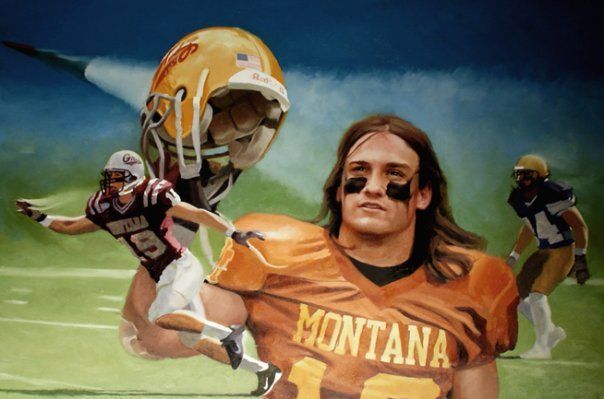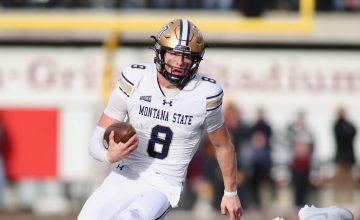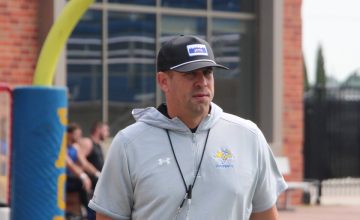Editor’s Note: This biography was written as part of the Montana Football Hall of Fame, of which Colt Anderson was an inductee in the Class of 2023. For more information on the Montana Football Hall of Fame, visit mtfootballhof.com.
On the surface, Colt Anderson’s story is one of an underdog triumphing over long odds over and over again.
But when one dives into this person’s makeup, it quickly becomes apparent that the man who earned the nickname “the Butte Missile” was perhaps destined to become one of the most successful Montanans to live a football life.
Anderson, who hails from the Mining City, has defied the odds ever since he emerged from a winless high school football team his senior year as walk-on at the University of Montana. Yet he and those around him always knew he would achieve great successes.
Despite walking on at UM, Anderson wasted little time affirming himself as one of the greatest players in Griz football history, earning first-team All-Big Sky Conference honors three times while establishing a reputation as one of the hardest hitting safeties ever at UM or in the Big Sky.
Once into the NFL, he had to start all over, working his way from practice squad to kick team units to, eventually, starting for several of the most storied franchises in professional football.
And that life of football continues today as Anderson continues his work in the NFL as an assistant coach on Zac Taylor’s staff for the high-flying Cincinnati Bengals.
Hundreds of men either from Montana or who played collegiately in Montana (or both) have gone on to compete in professional football. Very few have done it for as long or as consistently as Anderson did.
For his longevity, consistency and general excellence, Anderson is one of the headlining members of the Montana Football Hall of Fame Class of 2023.
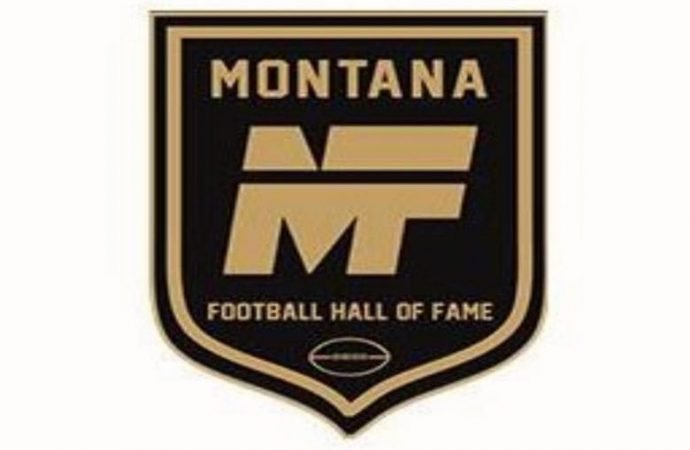
“The thing that made Colt stand out most as a football player is decisive urgency,” said Tom McMahon, a Helena native and Carroll College alum who has been an NFL special teams coordinator since 2007. McMahon is currently the special teams coordinator for the Las Vegas Raiders and coached Anderson for the two seasons Anderson played for the Indianapolis Colts.
“There’s not a lot of guys who have that. He is very decisive and really fast. He sees it and when he does, he is going 100 percent. And 99 percent of what he sees is correct. He almost never makes mistakes and it makes his play speed seem even faster. That’s how you play a decade in the NFL.”
Anderson played nine seasons in the NFL, working his way from the Minnesota Vikings’ practice squad as a rookie in 2009 to starting games for both the Philadelphia Eagles and the Indianapolis Colts. He played on five playoff teams and was a part of five playoff wins between 2010 and 2017.
Only four Griz alums — Guy Bingham, Tim Hauck, Mike Tilleman and Scott Gragg — played longer in the NFL. And Anderson equaled Kirk Scrafford’s nine seasons in the League.
“The whole body of work is so impressive when you look at it,” said Tim Hauck, a Griz legend in his own right who pioneered Montana’s iconic No. 37 jersey. Hauck played 13 seasons in the NFL before returning to Missoula and coaching Anderson for most of his time with the Griz.
“Play after play, big hit after big hit, it was never one game here or one game there, it was always the consistency of his performance that was so impressive. To play that long in the NFL this day and age is incredible.”
Not bad for a kid from a “mile high, a mile deep” who went from playing on a Butte High School Bulldogs team that didn’t win a game during the 2003 season to earning a reputation as a special teams ace for NFL playoff teams led by quarterbacks like Michael Vick in Philly and Andrew Luck in Indy.
Now he’s coaching for the Bengals during the rise of Joe Burrow. Cincinnati had the worst record in the NFL the season before Anderson joined Taylor’s staff. Over the last two seasons, Cincy appeared in Super Bowl LVI and the AFC championship game, respectively.
“He knows what to teach and how to tell these guys what they need to do to be a part of an NFL roster,” Tim Hauck said. “If they will listen, they’ll get it done and if they don’t listen, they won’t. He’s been through the wars so he immediately has their respect.”

Folks from Butte knew who Anderson was…because that’s how folks from Butte are.
In Butte, high school sports are a religion. And Colt’s father, Mike Anderson officiated high school and Frontier Conference hoops for more than four decades. Mike also coached his three sons in baseball growing up and was a defensive backs coach at Butte High during his sons’ high school careers. Colt’s mother Michele Anderson taught dance when she wasn’t busy chasing around her three sons and daughter, Brianna.
During his prep days, Colt was more well-known on a state-wide level for his exploits on the basketball court as a gritty, tough and efficient guard for John Thatcher’s Bulldogs. Anderson’s first big athletic achievement in Missoula actually came the winter before he walked on with the Griz.
He led a Butte High team playing in its first state tournament since 1990 to a pair of victories over Bozeman and Billings West, respectively, in that 2004 basketball tourney. The wins punched the Bulldogs’ ticket to the Class AA state title game.
“Colt made an incredible contribution to our basketball team, No. 1, leadership. No. 2, he was extremely coachable. I didn’t let Colt shoot because he never came to open gym, he never proved to me he could shoot,” joked Thatcher, Butte High’s head boys’ basketball coach for years and currently an assistant women’s basketball coach at Montana Tech in Butte.
“But he always picked up the toughest defensive job. Prime example, when we beat Billings West Colt’s senior year, they had that great guard who’s dad was the coach, Chase Sukut. (Colt) did a great job of guarding him. We didn’t have the athletes but we controlled the tempo.”
Almost 7,000 fans packed the Adams Center — a vast majority of them dressed in Butte purple. Yet the Cinderella run fell short as Great Falls CMR won its fourth Class AA title in five years in a defensive slugfest.
“Colt was our best defender, but that’s only part of it,” Thatcher said. “I can’t say enough about the person he is. Salt of the earth.
“He was such an unselfish athlete and he knew what it took to win. You try to convince high school athletes that it’s not about each one of you individually; it’s about how we perform. It doesn’t matter who scores, it’s all about what it takes to win. He executed EXACTLY what I asked of him. High school kids don’t do that.
“He was the leader, no question about it.”
Anderson was a three-sport athlete who also excelled as a shortstop on baseball diamond. Colt’s father was a longtime baseball coach and his oldest brother, Beau, was also a standout player.
Colt’s senior season of football did not reap a win. So the surge through the hoops state tournament, despite the disappointing final loss to CMR, helped show Anderson knew how to win. It also first showed Thatcher the character of Anderson.
“I have a saying I have said to every team I’ve ever coached: never forget who you are, never forget where you came from and never fear anything,” Thatcher said. “He falls into all three of those categories. His worth ethic is and was second to none. There are very few people out there that paid the price he did to make it to the NFL. And you could see that when he was a teenager.”

The Bulldogs — who played at a middle school field back then rather than iconic Naranche Stadium like Butte High does now — might’ve had a hard time breaking through. Yet Anderson’s toughness stood out as an individual talent throughout his high school career.
“We watched him a lot in high school and for some reason, most of the film we watched, he was playing tailback and he was really good,” Montana head coach Bobby Hauck, who spent 2003 through 2009 at UM before returning ahead of the 2018 season to lead his alma mater, said in the spring of 2023. “He wasn’t very big. But he ran well and he was tough, really a good running back.
“We didn’t see him as a running back in college but we were trying to project him. I was so stupid I didn’t offer him a scholarship (laughs). We ended up convincing him to walk on to play safety.”
Although he loved basketball and baseball, ultimately, Colt’s attention settled upon football when it came to his post-prep days.
“Growing up, my brothers had opportunities to play college football and neither one of them did,” Anderson said. “My oldest brother, Beau, went to play college baseball (at Walla Walla Community College) and my brother Luke had an opportunity to play at Montana Western and he didn’t want to pursue football.
“So when I had an opportunity to walk on, I thought at least one of us has to try to do this because I thought both those guys were better football players than me. They were bigger than me. The fact that they didn’t do it, I felt like I needed to do it.”
Tim Hauck — who had his first college coaching job came working for his older brother between 2004 and 2007 — instantly noticed Anderson’s sharp explosiveness, fearless pursuit and natural abilities at safety.
“Tim kept coming to our personnel meetings during spring ball, fall camp when Colt was a young guy and saying, ‘He’s our best safety. What’s the hold up? Let’s go!” Bobby Hauck remembered. “I’m always putting the brakes on, watching them more, making sure they are ready. Then it became apparent pretty early on, probably a year and a half in, that this guy is going to be a special player for us.”
“I tried to tell my brother that Colt was the best safety we had,” Tim confirmed with a laugh. “He’s explosive, instinctive, tackles well, runs well. Once we believed what he could do, he made the most of it.”

The story of football in Montana has deep roots in the Mining City. Partly because of the late Sonny Holland and the enormous influence he had on Montana State’s first 20 years in the Big Sky Conference, Butte was a Bobcat town for most of the 1970s and ‘80s.
The emergence of players like Todd Erickson in the early 1990s started to shift the Mining City’s allegiance. Butte is the hometown of 99 lettermen for the University of Montana football team.
The first Griz ever drafted in the NFL Draft came out of Butte. Milt Popovich was selected with the 15th pick of the second round of the 1938 NFL Draft by the Chicago Cardinals. The man known as the Butte Bullet is still the highest ever draft pick out of UM.
And the most recent Griz to make an NFL active roster is also from Butte: offensive lineman Dylan Cook signed with the Pittsburgh Steelers in May of 2023.
Anderson had two uncles who played for each Montana (Pat Sullivan and Dave Manovich) and Montana State (Barry Sullivan and Jim Anderson). One of his best friends growing up was Cole Salo, who’s uncle Greg Salo was the defensive coordinator at MSU in the 1990s before taking over as the head coach at Butte High in the early 2000s. So Anderson had ties on both sides of the rivalry.
“He was a great all-around athlete, played basketball, baseball, and on the football team, we used him all over the place,” said Salo, who’s now retired and golfing as much as possible. “He is a great all-around athlete, great competitor with a great work ethic, which we learned to find out how far that can take you after he walked on to the Griz.
“The underdog, chip on your shoulder, whatever cliché you want to use, that 100 percent drove Colt. That was what he was going to use to motivate him to get the most out of his ability.”
Anderson didn’t give it a second thought when Bobby Hauck extended a walk-on offer to join a Griz team that was in the midst of a run of 12 straight Big Sky Conference championships.
“Butte was a Griz town when I was coming up,” Anderson said. “They were rolling at the time and they were out-recruiting Montana State with Butte guys. There was a handful of Butte guys on that national championship team in 1995.
“In 4th grade, I was 10 years old (in 1995) and my fourth grade teacher was Dave Dickenson’s aunt. That was a school year I will always remember. Everyone from my class grew up big Griz fans because of that 1995 team.”
So often, the story of the in-state walk-on at Montana is one of being buried on the depth chart for years before getting an opportunity to break out. Anderson rose through the ranks almost immediately, earning a starting job as a sophomore.
“He’s a great tackler, he’s a great hitter, has good instincts, fearless, all those things that you love about safeties in our defense,” Bobby Hauck said. “He had it all.”
That 2006 season, Anderson rolled up 96 tackles and earned his first of three straight first-team All-Big Sky honors. That Griz season ended in a Big Sky Conference championship, one of four straight that Anderson helped contribute to during his time in Missoula. That Griz team also went on a march to semifinals of the 2006 FCS Playoffs.
The following season, Anderson was equally consistent and impactful, rolling up 85 tackles, including seven for loss, forcing three fumbles and intercepting four passes. He was an All-American for the first time. But his junior season ended in disappointment.
The top-ranked and undefeated Grizzlies lost 23-22 to Wofford in the first round of the playoffs. The upset loss to a triple option team left a bitter taste in Anderson and his returning teammates’ mouths.
In 2008, behind one of the great single seasons by any Griz defensive players in program history by Anderson, the Griz rolled to 14 victories, including an 11-1 finish in the regular season. They steamrolled the Bobcats in Missoula after a quick and iconic wardrobe change and carried that momentum into the playoffs.
“We did senior night the week before the ‘Cat game against Idaho State and we thought that was weird,” Anderson said. “There was whispers going around that. Then the day of the game, we are in our team room and Coach Hauck comes in with this big duffle bag.”
Montana had warmed up in its traditional maroon and silver jerseys. But right before the famed tunnel run on that November afternoon, the Griz changed into throwback Copper and Gold jerseys. Montana State never had a chance as the Griz rolled to a 38-3 victory to spark another playoff run.
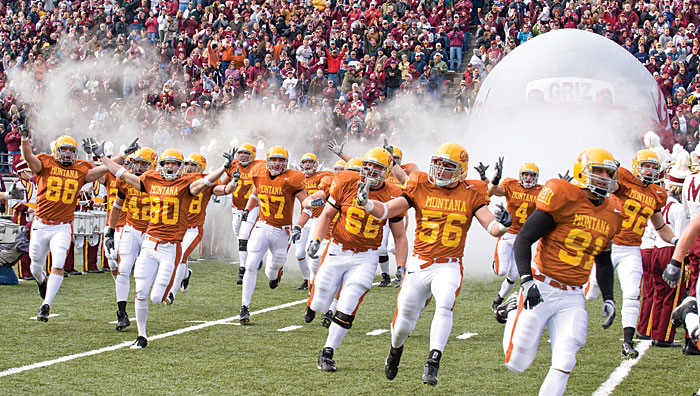
“It still gives me goosebumps to this day thinking about that tunnel run and that game,” Anderson said. “I don’t think the University of Montana had worn those colors since (the national championship season of) 1995 so to be able to represent the University of Montana with the old school colors, the greats I grew up watching, the Dave Dickensons, all the Butte guys, those are the colors I watched the Griz play in as a kid so to wear those same colors, me and all the Montana guys on that team, for us, it was such a special day.”
The following week in the playoffs, the Griz kept chugging. Montana had no trouble with Texas State, drilling the now FBS Bobcats, 31-13. The following week, the Griz avenged the only Big Sky Conference loss they suffered between 2006 and 2009 when they defeated Weber State 24-13.
That win over the Wildcats set up a clash of titans. In 2004, during Hauck’s second season, the Griz rode a hot streak all the way to the national championship game, only to lose to James Madison University.
Four years later, Montana got another shot. But this time, UM had to go to Harrisonburg, Virginia to play the No. 1 ranked Dukes.
In what Bobby Hauck still calls “one of the finest wins in school history”, Montana bludgeoned Walter Payton Award winning JMU quarterback Rodney Landers and the top seeded Dukes, 35-27, to earn UM’s sixth trip to the national title game, all since 1995.
“They were No. 1 in the nation and we beat them on the road,” Bobby Hauck said.
“Colt and the guys in his class all performed in that game. Colt had a big night and JMU had some really skilled players and Colt and our defense really showed up. Colt led the charge in that game and that was an enormous win for the Griz.”
Anderson was a part of Griz teams that went 45-8 between 2005 and 2008, but his final game as a Griz ended in heartbreak. After the landmark win at JMU, Montana ran into a brick wall. Defensive end Lawrence Sidbury had a coming out party coming off the edge to spark a 24-7 Richmond runaway in Chattanooga, Tennessee.
Despite that disappointing ending to his Griz career, Anderson earned a reputation as an all-time Griz great. He piled up 313 tackles, which still ranks in the top 10 in school history. His 129 tackles a senior is the seventh-most ever by a Griz.
Anderson is also one of only five Grizzlies to ever win multiple Tony Barbour Awards, given each year “ to the Griz who best exemplifies outstanding practice habits and makes an unselfish contribution to the betterment of the Grizzly football team.”
Anderson won the Golden Helmet Award in 2007 and 2008 as the hardest hitter on the Griz and he also was the 2008 Steve Carlson Award winner as the team’s overall MVP.
“He was hard-nosed, he did everything right, he worked hard and he had all the intangible stuff and when he finally got on the field, you saw his athletic ability take over also,” Tim Hauck said. “That’s a great recipe for a really great football player.”
Although the disappoint of his final game as a Griz stung, Anderson hoped he didn’t have to stop playing football.
And he made sure of it with an unforgettable pro day that helped solidify what Tim Hauck knew to be true all along. The Butte Missile was an NFL caliber safety and special teams stalwart who would get a shot to play on Sundays, even if he had to prove himself all over again.
Many thought that Anderson would get drafted. Instead, he ended up signing with the Minnesota Vikings. He flirted with the active roster but ultimately spent the 2009 season on the practice squad.
He signed with Minnesota’s practice squad in September of 2010. By November, the Eagles signed him to a three-year contract that elevated him to the active roster.
He played in eight games for the Eagles in 2010, rolling up 16 tackles and, like Tim Hauck, established himself as a special teams ace that the Philly faithful noticed and appreciated.
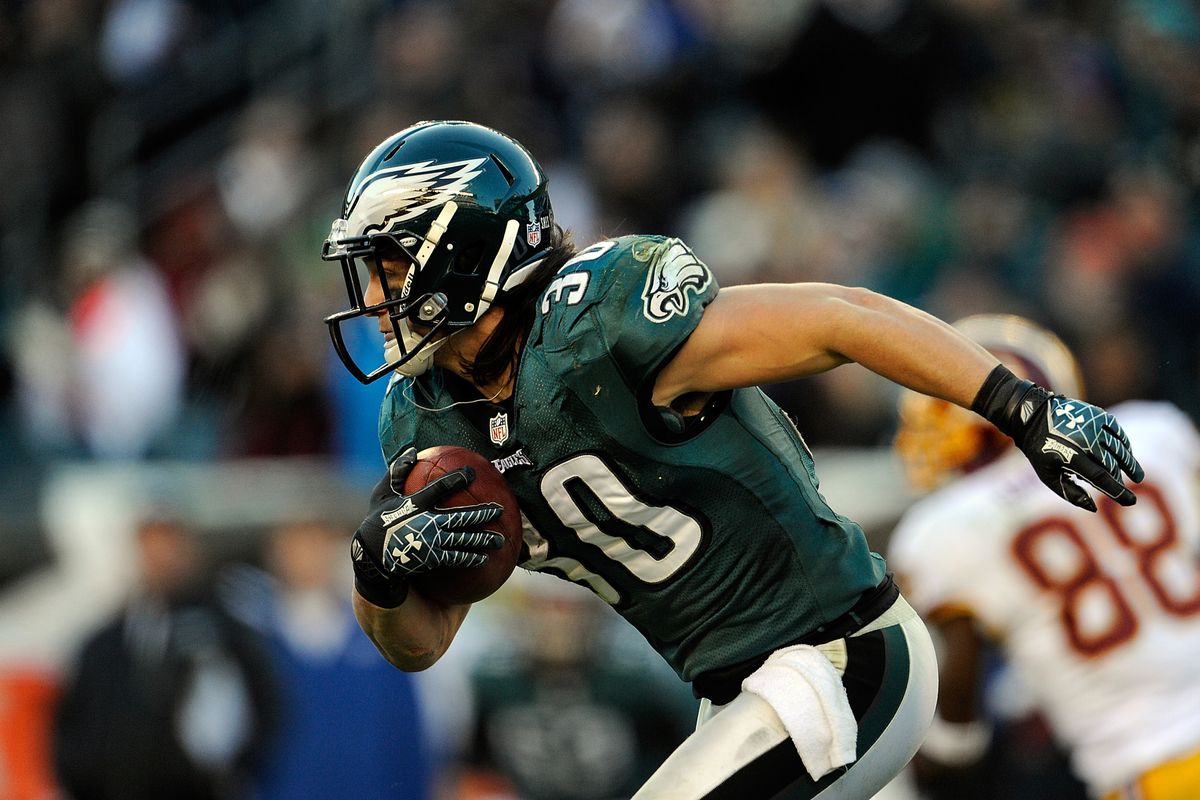
“Being a walk-on was very similar to being undrafted,” Anderson said. “Your back is against the wall and you get over looked a little bit. They have the guys they drafted just like in college where they have guys they gave scholarships to. I knew I had my work cut out for me, but it was a challenge I was willing to accept. I just approached it like I did in college, where I was going to outwork my opponents, which were my teammates and show the coaches that I deserved a shot.”
The following year, Anderson was playing at a Pro Bowl level on special teams through 12 games. Then disaster hit — he tore his ACL.
As has been the proven pattern of his life, Anderson was not deterred. And he returned to full strength by 2012. His fourth season in the NFL happened to be the first that he worked his way into the starting lineup.
Anderson played in 48 games and started six during his four seasons in Philadelphia, compiling 71 tackles, three forced fumbles and his first (and only) career interception.
“He was ALWAYS confident in his ability to compete in the NFL,” Bobby Hauck said. “There’s a lot of people who might think they can play in the NFL but they can’t. Colt can.
“He was tough enough to handle both the mental aspect of trying to make the team every year and the physical aspect of competing in the kicking game at a high level, which is a high-speed, hard collision type game every time you are in there. He’s a fine football player who maximized his ability.”
By the time he signed with the Colts in 2014, Anderson had a well-earned reputation as a steady performer who could have an elite impact on an NFL special teams unit, plus he was a viable option as a safety that carried himself with professionalism.
McMahon hails from Helena. The Capital High and Carroll College alum first recognized Anderson while watching film of the Eagles. He wanted to get the fearless gunner on his team right away.
“I remember watching his tape and I knew he played with some real urgency,” McMahon said. “It’s rare, what he has.
“I was in Coach (Chuck) Pagano’s ear every single day. Through the free agency process, I wanted Colt every single day. I would leave a note on Pagano’s desk every single day, saying either ‘Colt’ or ‘Anderson’, just bugging him relentlessly. But finally, they brought him in for a visit and they saw his talent, too.”
Anderson spent two seasons in Indianapolis before making one more move during his playing days. He landed with the Buffalo Bills for the 2016 and 2017 seasons. He spent most of his final two seasons in the NFL on injured reserve before retiring.
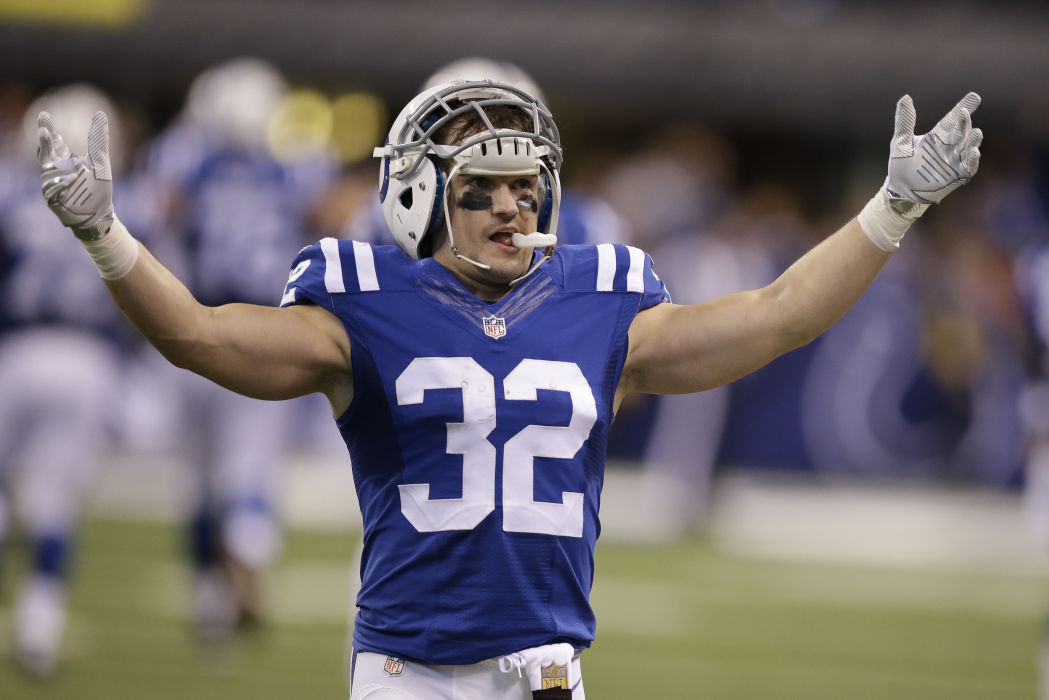
“He is one of the top five best teammates I’ve ever seen since I’ve been in the league,” McMahon said. “He epitomizes what a teammate should be. And on top of that, he’s a great person and a great communicator.
“And he produces. Good teammates produce. They get out on the field and they make plays. They are good in the locker room, too. But I’m a great guy but I could never play in the NFL. There’s a lot of people who could be a great teammate because they are great people. But you have to be able to play. Colt went out and produced.”
Hundreds of Montana football legends hail from Butte. But Anderson is a modern day Mining City hero. And like Thatcher taught him, he never forgot his roots. It’s an important part of his legacy and the Anderson family name.
“He’s always kept Butte, America close to his heart,” Bobby Hauck said. “Over the years, he and his family, they have always gone out of their way to keep in touch with his college teammates, his college coaches. Their family is so tight. He is a true Montanan, a true Butte guy and he’s proud of that fact. It’s such a part of who he is and it’s one of the things that makes him so special.”
Each summer, Anderson hosts a two-day even called the “Dream Big Montana Experience” where he and his NFL friends rally together in Butte to give local and statewide kids an unforgettable few days that Anderson hopes inspires the next generation. The event includes a skills camp, a summer kick off concert and a BMX show, a family-fun day, and a gala.
“He’s done so much for this town and for kids,” Thatcher said. “He does his camp every summer and he brings in all the big time athletes, the former NFL guys. He has a business here (UpTop Clothing with his brother, Luke) and he has the Mo Club in Missoula with his brother, Beau. He pays attention to business, dots his I’s and crosses his T’s at every road way.
“As an old guy like I am, he’s a real special person to me. There’s no arrogance about him. He has never demonstrated any ego. You could be a stranger on the street and he will be with you when you are talking to him. He’s as down to earth as you can get and he doesn’t have to be as far as I’m concerned. He’s paid his penance, paid the price and he’s accomplished more than most Butte people that have ever come along.”
Anderson has had steadying presence throughout his entire life journey: his wife, Keelie, who’s been his other half since the couple was in high school. The Andersons have four boys: Cage (11), Krew (10), Coye (6) and Kace (2). Each is very involved in a variety of sports, including hockey and baseball.
Throughout his career, Anderson has always kept ties to Butte. Often in the off-season during his playing career, the Anderson clan would come back to Butte before embarking on the next adventure wherever Colt was playing at the time. Now the family is in Cincinatti full time as the Bengals chase the first Super Bowl in franchise history.
Sports have always been a huge part of Colt Anderson’s life, whether as a kid or as a father. From Butte High to the University of Montana to living all over the country working in the NFL, a few key factors have never waivered during Anderson’s football life.
“A lot of people say faith, family and football and I look back at my life and that’s what it’s been,” Anderson said. “Family is very important to me. My faith is important to me. And football has been a huge part of my life. It’s always been something in my life that I’ve always had.
“When I took two years off, I felt like something was missing. So to be able to come back and coach and be on the other side has been a blessing. Football has been such a huge part of my life.”

